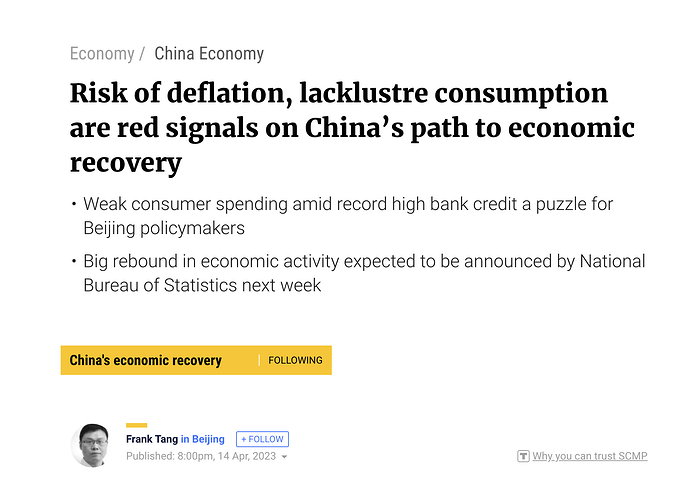-
这篇文章提到,在银行信贷创历史新高的情况下,消费支出疲软成为北京决策者的难题
-
国家统计局下周预计将公布经济活动的大幅反弹。
-
文章说,
-
中国出现了生产者价格下降和消费者价格缓慢上升的情况,导致了关于通货紧缩和需求不足风险的警告。
-
尽管如此,中国政府在第一季度扩大了创纪录的10.6万亿元人民币的银行信贷,使得中国在应对高通胀和市场动荡时比西方同行处于更好的地位。
-
分析师说,需要更有力和有针对性的政策来解决两个顽固的问题:修复家庭资产负债表和恢复投资者信心。
-
中国的经济参数包括消费支出疲软,CPI涨幅低,银行信贷和货币供应量增长创历史新高。
-
各部门的不均衡反弹可能会破坏经济复苏,预计下周国家统计局发布第一季度数据时,经济活动将出现大幅反弹。
-
市场对中国大流行后消费反弹的规模和出口的预言仍然存在担忧。
-
对中国经济下行风险的担忧已经出现,因为中国经济增长的两个传统动力–出口和消费–被怀疑已经失去动力,投资也因高额债务而受到抑制。
-
人口挑战等长期不利因素,以及发展数字经济和本土创新的努力已经感受到了美国禁止向中国出口高端芯片的影响。
-
研究发现,今年20个主要消费类别中的一半表现相对较弱,而食品和饮料、医疗、电信服务、地铁交通、珠宝和手表方面的支出则很强劲。
-
面对美国的脱钩压力,中国的市场和消费潜力是吸引跨国公司的主要因素。
-
第一季度家庭存款增加了9.9万亿元,去年增加了17.8万亿元。
-
预计中国今年的GDP增长将超过5%,在年底时的季度增长会更高。
-
3月出口同比增长14.8%,但中美竞争导致的全球经济增长前景疲软可能会改变贸易环境。
-
总部设在北京的国民经济研究所副所长王小鲁将CPI的低增长归因于产能过剩和消费需求不足。
-
国际货币基金组织(IMF)敦促采取更多行动来稳定中国的房地产市场。
-
房地产正在吸引中国家庭的更多投资,为消费价格的滞后提供了另一种解释。
-
第一季度,中长期家庭借款同比下降11.8%,但3月份的数字比一年前跃升了70%。
-
IMF建议采取积极措施,恢复对房地产行业的信心,以限制负面的宏观金融溢出效应的风险。
-
China has seen falling producer prices and slow-rising consumer prices, leading to warnings about the risk of deflation and inadequate demand.
-
Despite this, Beijing has extended a record 10.6 trillion yuan in bank credit in the first quarter, allowing for a better position than Western peers dealing with high inflation and market turbulence.
-
Analysts say more forceful and targeted policies are needed to tackle two stubborn issues: repairing household balance sheets and restoring investor confidence.
-
Chinese economic parameters include weak consumer spending, low CPI rises and record high bank credit and money supply growth.
-
Uneven rebounds across sectors could undermine the economy’s recovery, and a big rebound in economic activity is expected next week when the National Bureau of Statistics releases first-quarter data.
-
Market concerns persist over the scale of China’s post-pandemic consumption rebound and the prognosis for exports.
-
Concerns about China’s economic downside risk have been raised, as two of its traditional drivers of growth – exports and consumption – are suspected to have lost steam, and investment has been curtailed by high debts.
-
Long-term headwinds such as demographic challenges, and efforts to develop the digital economy and home-grown innovation have felt the impact of a US ban on high-end chip exports to China.
-
Research has found that half of the 20 major consumer categories have performed relatively weakly this year, while spending on food and drink, medical care, telecoms services, subway transport, jewellery and watches is strong.
-
China’s market and consumption potential is a major draw for multinational companies in the face of decoupling pressure from the US.
-
Household deposits increased by 9.9 trillion yuan in the first quarter, and 17.8 trillion yuan last year.
-
China is expected to have GDP growth of more than 5% this year, with higher quarterly growth towards the end of the year.
-
March exports rose 14.8% year on year, but the weak prospects for global economic growth due to US-China rivalry could change the trade environment.
-
Wang Xiaolu, deputy director of the Beijing-based National Economic Research Institute, attributes the low CPI growth to overcapacity and insufficient consumer demand.
-
The International Monetary Fund (IMF) urged more actions to stabilise the Chinese property market.
-
Property is drawing more investment from Chinese households, offering another explanation for lagging consumer prices.
-
Medium- and long-term household borrowing fell 11.8% year on year in the first quarter, but the March figure jumped 70% from a year earlier.
-
IMF suggested proactive measures to restore confidence in the real estate sector to limit risks of negative macro-financial spillovers.
Moderate deflation is a sign of solid and sustainable growth.
